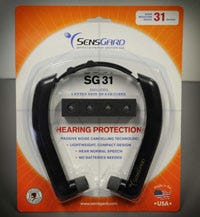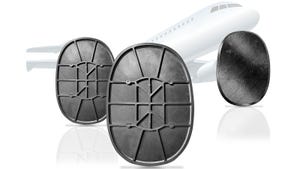What's that you say? Injection molder helps inventor successfully market new ear protection device
A new product and a new partnership are leading to success for custom injection molder Polymer Conversions Inc. and its customer, SensGard LLC, maker of hearing protection devices.
June 25, 2010
A new product and a new partnership are leading to success for custom injection molder Polymer Conversions Inc. and its customer, SensGard LLC, maker of hearing protection devices. Rob DiNardo and Greg Post, cofounders of SensGard LLC in Fairport, NY, obtained an exclusive license from Syracuse University to manufacture, market, and sell a technologically advanced hearing protection device developed by Jozef Zwislocki, a former Harvard Fellow from Switzerland, former professor at Syracuse University, and research fellow who founded the Institute for Sensory Research. Zwislocki maintains an office at Syracuse University.
 Rob DiNardo explains that Zwislocki, who has a Ph.D. in electrical engineering, used his scientific research to develop a hearing protection device that uses the physics of sound-canceling technology to protect hearing. "It's a work of scientific art that is so simple and lightweight that people can't believe it works so well," says DiNardo. He understood how to apply sound-canceling technology.
Rob DiNardo explains that Zwislocki, who has a Ph.D. in electrical engineering, used his scientific research to develop a hearing protection device that uses the physics of sound-canceling technology to protect hearing. "It's a work of scientific art that is so simple and lightweight that people can't believe it works so well," says DiNardo. He understood how to apply sound-canceling technology.
DiNardo and Post want to change the conventional method of hearing protection (ear plugs and ear muffs). "The problem with the foam ear plugs is the wearers never get the protection intended because they are difficult to get into the ear," explains DiNardo. "You have to roll them tightly and push them deep into the ear. People do this with dirty fingers, making it unsanitary. And, it muffles noise, which means you can't hear people speak clearly."
The SensGard Zem allows the wearer to hear people speak clearly due to the design of the device. Zwislocki's technology uses sound to cancel itself through a unique application of a chamber that attracts the sound, passes through acoustic material, and then reflects off the chamber. As sound starts coming back down the chamber, incoming sound cancels the sound coming back down the chamber, and does so very efficiently. Additionally, adds DiNardo, the Zem is more comfortable and easy to use.
SensGard had an aluminum prototype tool made by a moldmaker in Rochester, NY, to enable it to get initial product. When DiNardo attended a supplier fair for Lockheed Martin, he went hoping to present the Zem hearing protection device to the large multinational aerospace manufacturer, and sell thousands of the product.
Ben Harp, COO of Polymer Conversions, was also at the supplier fair, and he and DiNardo struck up a conversation. "We were still making the Zem out of our prototype tool, but it was wearing out. So Ben invited us out to see Polymer Conversions' facility," says DiNardo. "We did our homework on the company, getting references from suppliers, and found that they had good capabilities and would do a good job for us." SensGard was ready to take the product to the next level, and market the Zem device globally.
However, DiNardo says he quickly learned that production molds needed wouldn't be an inexpensive proposition. That's when Harp introduced DiNardo and Post to a funding opportunity at the University at Buffalo's Center for Advanced Biomedical & Bioengineering Technology (UB CAT), which offered a program through the New York State Foundation for Science, Technology & Innovation. UB CAT made available grants of up to $200,000 for the commercialization of technological advancements to help New York-based businesses gain a technological advantage over their competition.
Under the guidance of Donald Henderson, UB professor in the Dept. of Communicative Disorders & Sciences, the UB CAT program was able to support the development project with matching funds that provided an incentive for SensGard to proceed with the Polymer Conversions partnership.
"The tooling used for initial production of the Zem device was development tooling," says Harp. "We then built high-volume tooling and in the process, used our engineering resources to fine-tune aspects of the product design."
Polymer Conversions produced 100 samples of the Zem hearing protection devices in November 2009, with the first production run completed in early February 2010. SensGard has since ordered another 6000 units from the two four-cavity molds it purchased from Polymer Conversions. Another mold to produce the headband was built by a moldmaker in Rochester that was recommended by Polymer Conversions.
In addition to the molding of the ear pieces, Polymer Conversions, a full-service contract manufacturer in Orchard Park, NY, does all the assembly and packaging, and then boxes the ZEM hearing protection devices in specially made boxes of 100, and ships for SensGard.
Polymer Conversions specializes in tight-tolerance medical devices, medical components, biometrics devices, and gear parts. The company operates with ISO 9001:2008 standards and is working to obtain ISO 13485 for medical OEM and FDA requirements as it serves the medical/dental/healthcare industries, as well as the safety, personal care/packaging, electronics, business equipment, and automotive markets. Molding production consists of 20 injection molding machines that are a mix of hydraulic and electric, ranging from 28-390 tons clamping force, all equipped with robotics for part removal and protection of molds.
The company recently added 28,000 ft2 of space for additional cleanroom production, QA, assembly, and warehousing, giving Polymer Conversions a total of 55,000 ft2. The cleanroom production is Class 7 and Class 8 certified and includes molding, assembly, and packaging.
SensGard also offers a hard hat clip for the Zem so that the headband lies behind the head, yet is not against the neck, for greater comfort. Polymer Conversions also molds the hard hat clip. "You can fold it up and clip the Zem permanently with the hard hat so you're never without your hearing protection," says DiNardo. Zem comes in two models: the SG26, which weighs 1.3 oz, and the SG31, which weighs 1.7 oz for higher noise cancellation.
DiNardo and Post are excited about Zem technology, but know that any new technology gets resistance from the old. "Large earplug companies are lobbying hard to make sure our product doesn't get to market," says DiNardo. "That's how technology gets thwarted. Some people will always prefer the old-style ear plugs, but we hope this technology will result in a new paradigm for hearing protection."—Clare Goldsberry
About the Author(s)
You May Also Like




